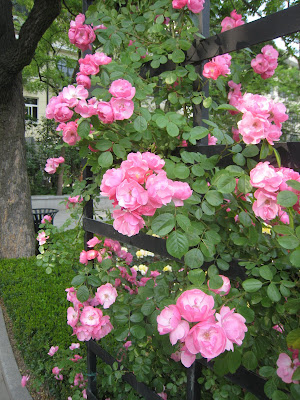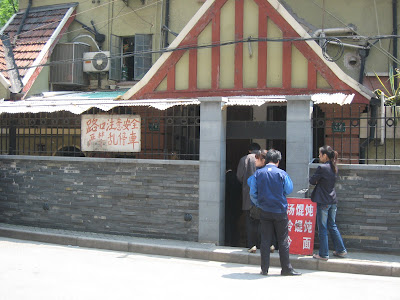While so far I've been speaking about the best restaurants in terms of my favorite food website Dianping.com, Din Tai Fung doesn't get particularly high marks on the site - reviews are positive but often lukewarm, with good service and high prices being frequently mentioned. On the other hand, expat site after expat site raves about Din Tai Fung's xiaolongbao, and the always-fun-to-read Christopher St. Cavish, restaurant reviewer for SH Magazine, even named their pork & crab xiaolongbao as the #1 dish to try in Shanghai.
 Anyway, it's hard to directly compare this restaurant to say, Jia Jia Tang Bao. While that restaurant amounts to a dive with a line, Din Tai Fung, a Taiwanese chain, feels like an upscale restaurant. It's the type of place you might meet a business person, or do something really serious like that. There's a few branches of the chain throughout Shanghai, they're all in upscale locations, and the Lujiazui branch even has a nice view of the Huangpu River and the local skyscrapers:
Anyway, it's hard to directly compare this restaurant to say, Jia Jia Tang Bao. While that restaurant amounts to a dive with a line, Din Tai Fung, a Taiwanese chain, feels like an upscale restaurant. It's the type of place you might meet a business person, or do something really serious like that. There's a few branches of the chain throughout Shanghai, they're all in upscale locations, and the Lujiazui branch even has a nice view of the Huangpu River and the local skyscrapers:
 They serve a number of dishes from various Chinese styles, with a Hong Kong and a Shanghai slant to what's on offer. Of course the xiaolongbao are the reason I went, and they actually have three versions on offer: standard xiaolongbao, smaller xiaolongbao served in a pork broth, and a xiaolongbao where the insides are a mixture of pork and crab. It's worth mentioning they were all expensive, going for around thirty five kuai an order, with their orders being smaller than what's generally available at other xiaolongbao restaurants. They end up being around ten times more expensive than other places.
They serve a number of dishes from various Chinese styles, with a Hong Kong and a Shanghai slant to what's on offer. Of course the xiaolongbao are the reason I went, and they actually have three versions on offer: standard xiaolongbao, smaller xiaolongbao served in a pork broth, and a xiaolongbao where the insides are a mixture of pork and crab. It's worth mentioning they were all expensive, going for around thirty five kuai an order, with their orders being smaller than what's generally available at other xiaolongbao restaurants. They end up being around ten times more expensive than other places. But I'm willing to pay $5 for quality, and I didn't let the price bother me for these smaller xiaolongbao. They're about half the size of a normal xiaolongbao, and the idea is to put them in the broth, and then eat them as if a soup. It's enjoyed on a different level than standard xiaolongbao, with the flavors centered off the flavorful, rich, and gingered pork broth absorbed by the xiaolongbao's skin, but I enjoyed them:

But the main event was the xiaolongbao. Initial impressions were good: the vinegar was of the perfect strength, and even had sliced ginger in the dipping dish, the way I remember loving at Oakland's Shanghai Restaurant. It's subtler than one might expect, but gives the vinegar a better flavor:

Additionally, the skin of the xiaolongbao was obviousy very thin and meticulously prepared, while still managing to hold all the soup in. For xiaolongbao fans, the huge amount of folds on top is a thing of beauty:

But it all came crashing down after that. The insides of the xiaolongbao are really nothing at all special: the pork is dry and the soup is flavorless, and in the end the wrapper and the vinegar are mere accompaniments to the meat and the soup. I wasn't convinced the xiaolongbao were any better than that of another Taiwanese chain, the fast food restaurant Yong He Da Wang.
The small xiaolongbao in soup are still excellent, though. And the restaurant is clearly much classier than most any other place with xiaolongbao on the menu. So it might be worth having a look, even if I personally don't plan to ever go again. Also, the restaurant has branches in LA, Toronto, Sydney, and a number of larger cities throughout Asia.
Update 9/1/2009 - I went to the one in Arcadia (a suburb of LA) last year. A little expensive, a little salty, a little parking lot, and the atmosphere is cheap and old, but the xiaolongbao taste exactly the same. Decent xiaolongbao is hard to find in America, so even if I strongly recommend against this place in Shanghai, it's probably worth checking out for someone who happens to find themselves living in or driving through Arcadia.































